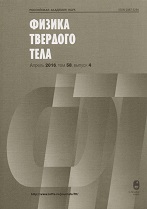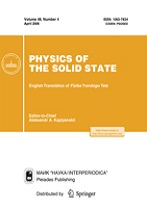|
This article is cited in 7 scientific papers (total in 7 papers)
Reviews
Diffusion model of the formation of growth microdefects: A new approach to defect formation in crystals (Review)
V. I. Talanin, I. E. Talanin
Zaporizhzhya Institute of Economics and Information Technologies, Zaporizhzhya, Ukraine
Abstract:
Theoretical studies of defect formation in semiconductor silicon play an important role in the creation of breakthrough ideas for next-generation technologies. A brief comparative analysis of modern theoretical approaches to the description of interaction of point defects and formation of the initial defect structure of dislocation-free silicon single crystals has been carried out. Foundations of the diffusion model of the formation of structural imperfections during the silicon growth have been presented. It has been shown that the diffusion model is based on high-temperature precipitation of impurities. The model of high-temperature precipitation of impurities describes processes of nucleation, growth, and coalescence of impurities during cooling of a crystal from 1683 to 300 K. It has been demonstrated that the diffusion model of defect formation provides a unified approach to the formation of a defect structure beginning with the crystal growth to the production of devices. The possibilities of using the diffusion model of defect formation for other semiconductor crystals and metals have been discussed. It has been shown that the diffusion model of defect formation is a platform for multifunctional solution of many key problems in modern solid state physics. Fundamentals of practical application of the diffusion model for engineering of defects in crystals with modern information technologies have been considered. An algorithm has been proposed for the calculation and analysis of a defect structure of crystals.
Keywords:
Defect Structure, Diffusion Model, Dislocation Loop, Defect Formation, Silicon Single Crystal.
Received: 08.07.2015
Citation:
V. I. Talanin, I. E. Talanin, “Diffusion model of the formation of growth microdefects: A new approach to defect formation in crystals (Review)”, Fizika Tverdogo Tela, 58:3 (2016), 417–427; Phys. Solid State, 58:3 (2016), 427–437
Linking options:
https://www.mathnet.ru/eng/ftt10033 https://www.mathnet.ru/eng/ftt/v58/i3/p417
|


| Statistics & downloads: |
| Abstract page: | 18 | | Full-text PDF : | 18 |
|





 Contact us:
Contact us: Terms of Use
Terms of Use
 Registration to the website
Registration to the website Logotypes
Logotypes







 Citation in format
Citation in format 
